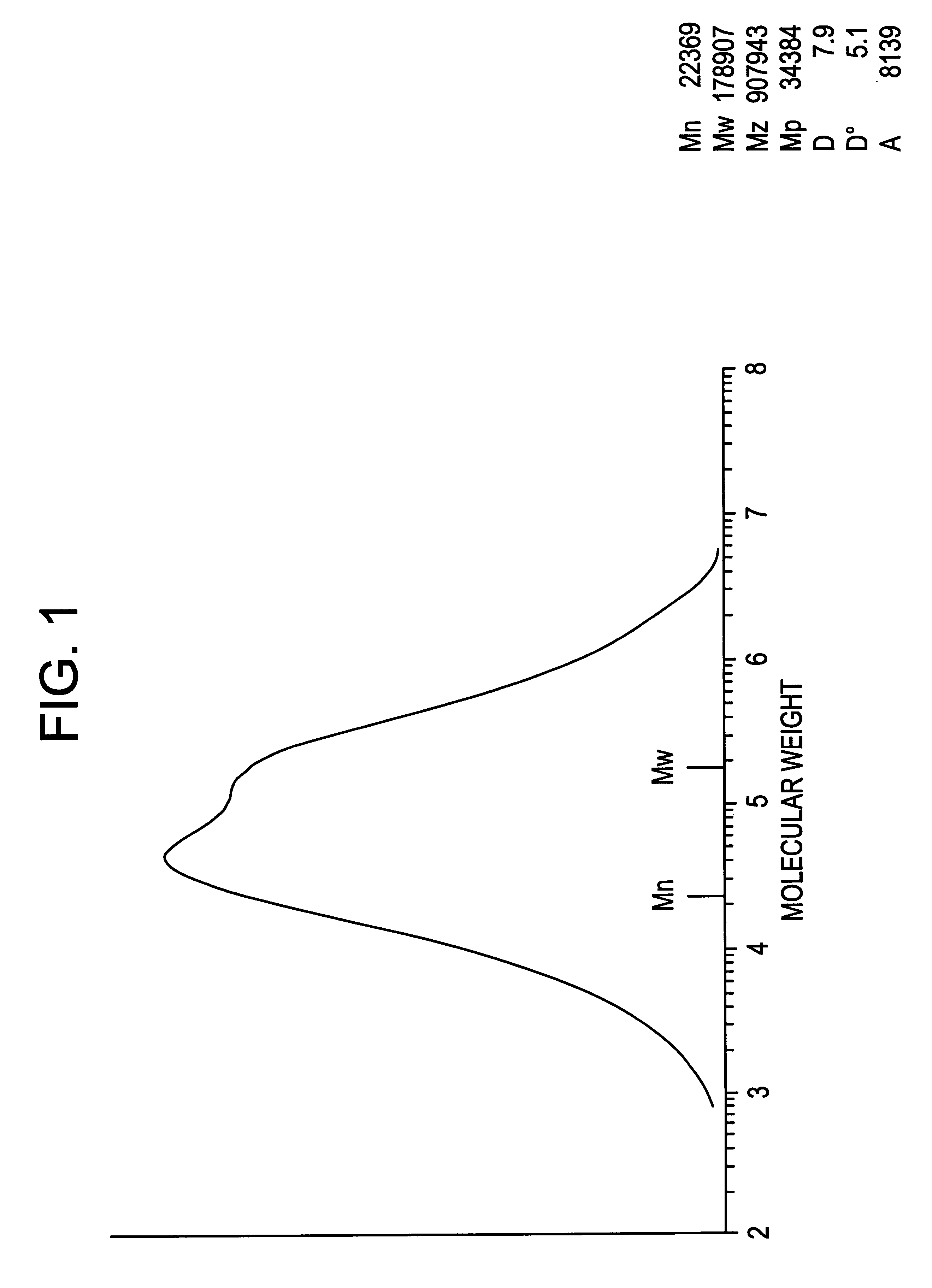Production of multimodal polyethylene
a polyethylene and multi-modal technology, applied in the field of multi-modal polyethylene production, can solve the problems of inability to produce lldpe with such low densities, inability to process and inability to meet the requirements of high molecular weight polyolefins
- Summary
- Abstract
- Description
- Claims
- Application Information
AI Technical Summary
Problems solved by technology
Method used
Image
Examples
example 2
The catalyst (Ph.sub.2 C) (Me.sub.3 SiCp)FluZrCl.sub.2 of Example 1 was employed in a copolymerisation process to produce a polyethylene copolymer. In a reactor, the ethylene comprised 6 wt % and the hexene comprised 9.7 wt % based on the weight of the diluent which comprised isobutane. The polymerisation temperature was 70.degree. C. No hydrogen was added to the reactor. The resultant polyethylene copolymer which was obtained was measured to have a density of 0.896 g / ml and an HLMI of 0.12 g / 10 min.
This first polyethylene product, was used to constitute a high molecular weight, low density fraction of a polyethylene pipe resin which comprised a physical blend of three separate polyethylenes. The second polyethylene comprised a medium density polyethylene homopolymer having a density of 0.953 g / ml and an HLMI of 2 g / 10 min. The medium density homopolymer was produced using a chromium-based catalyst which comprised 1 wt % chromium (in the form of oxide) on a silica-alumina support (p...
example 3
The (Ph.sub.2 C) (Me.sub.3 SiCp)FluZrCl.sub.2 catalyst of Example 1 was employed in a copolymerisation process to produce a polyethylene copolymer. In a reactor, the ethylene comprised 8 wt % and the hexene comprised 9.76 wt % based on the weight of the diluent which comprised isobutane. The polymerisation temperature was 70.degree. C. No hydrogen was added to the reactor. The resultant polyethylene copolymer which was obtained was measured to have a density of 0.905 g / ml and an HLMI of 0.03 g / 10 min. The molecular weight distribution was determined to have the following values: Mn 105 kDa; Mw 461 kDa; and MWD 4.4.
This first polyethylene product, was used to constitute a high molecular weight, low density fraction of a polyethylene pipe resin which comprised a physical blend of three separate polyethylenes. The second and third polyethylenes comprised a bimodal resin produced using two reactors in series with a Ziegler-Natta catalyst. The second polyethylene comprised a medium densi...
example 4
The catalyst (Ph.sub.2 C) (Me.sub.3 SiCp)FluZrCl.sub.2 of Example 1 was employed in a copolymerisation process to produce a polyethylene copolymer. In a reactor, the ethylene comprised 6 wt % and the hexene comprised 2.44 wt % based on the weight of the diluent which comprised isobutane. The polymerisation temperature was 80.degree. C. No hydrogen was added to the reactor. The resultant polyethylene copolymer which was obtained was measured to have a density of 0.925 g / ml and an HLMI of 0.08 g / 10 min, the polyethylene had an Mn of 124 kDa, an Mw of 424 kDa and a dispersion index D of 3.4.
This first polyethylene product was used to constitute a first fraction of an LLDPE bimodal polyethylene resin which comprised a physical blend of two separate polyethylenes. The second polyethylene comprised an LLDPE polyethylene copolymer also having a density of 0.925 g / ml and having an MI.sub.2 of 60 g / 10 min. The second LLDPE copolymer was produced using a metallocene catalyst ethylene bis (4,5...
PUM
| Property | Measurement | Unit |
|---|---|---|
| density | aaaaa | aaaaa |
| centroid-M-centroid angle | aaaaa | aaaaa |
| density | aaaaa | aaaaa |
Abstract
Description
Claims
Application Information
 Login to View More
Login to View More - R&D
- Intellectual Property
- Life Sciences
- Materials
- Tech Scout
- Unparalleled Data Quality
- Higher Quality Content
- 60% Fewer Hallucinations
Browse by: Latest US Patents, China's latest patents, Technical Efficacy Thesaurus, Application Domain, Technology Topic, Popular Technical Reports.
© 2025 PatSnap. All rights reserved.Legal|Privacy policy|Modern Slavery Act Transparency Statement|Sitemap|About US| Contact US: help@patsnap.com



